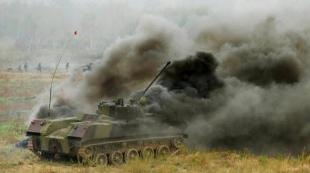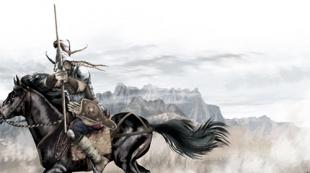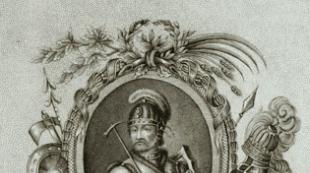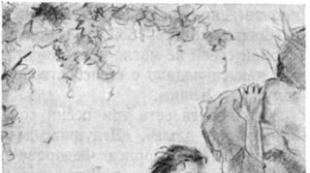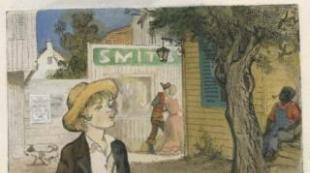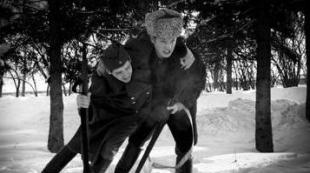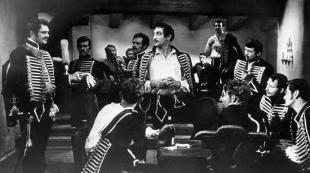Prince Oleg as a person. In what year did Prince Oleg's campaign against Kyiv take place? Consequences. March to Constantinople
Later 850 Birth of Oleg.
862 The date of the chronicle message about the calling to reign by the union of the Slavic and Finno-Ugric tribes of the Varangian dynasty - Rurik, Sineus and Truvor. The beginning of the reign of Rurik in Ladoga, Sineus in Beloozero, and Truvor in Izborsk. Arrival of Oleg as part of a detachment of Varangians to the lands of Northern Rus'.
864 Death of Sineus and Truvor. The chronicle indicates that “Rurik alone took over all power and began to distribute cities to his men.” Rurik and his retinue settled in a settlement at the source of the Volkhov.
Later 864 Oleg's participation in the military campaigns of Prince Rurik of Novgorod.
Later 864 Rurik's marriage to the "Urman princess" Efanda, Oleg's sister.
Later 864 Uprising in Novgorod under the leadership of Vadim the Brave against the autocracy of Rurik. Return of Rurik to Novgorod. The murder of Vadim the Brave by Rurik and the suppression of the uprising. The flight of many “Novgorod men” to Kyiv to avoid reprisals.
Later 864 Rurik's subjects Askold and Dir receive permission to go on a military campaign against Byzantium. Their arrival in Kyiv and the liberation of the city from Khazar tribute. The beginning of the reign of Askold and Dir in Kyiv.
Later 864 Birth of Prince Rurik of Novgorod and Efanda's son Igor.
865 Military campaign of the Kyiv prince Askold against Polotsk. Oleg's participation in the campaign of the Novgorod prince Rurik against Askold. Preservation of Polotsk under the protectorate of Rurik.
Later 865 Wars of the Kyiv prince Askold with the Drevlyans and the streets.
867 Arrival of the Byzantine bishop in Kyiv and mass baptism of the Rus. "District Epistle" of Patriarch Photius to the Byzantine bishops, where he reports on the baptism of the Rus.
869 The campaign of the Kyiv princes Askold and Dir against the Krivichi. Oleg's participation in the military campaign of the Novgorod squad against Askold and Dir.
Late 860s Oleg's appointment as Igor's tutor.
874 The campaign of the Kyiv prince Askold against Byzantium. Conclusion of a peace treaty between him and Emperor Basil I the Macedonian. Baptism of part of the Rus squad in Constantinople.
879 Death of Prince Rurik of Novgorod. Oleg's acceptance of guardianship over Rurik's young son Igor.
879 The beginning of the Novgorod reign of Oleg as “the eldest in the family of Rurik.”
Late 870s The Rus' campaign to the Caspian Sea and the attack on the city of Abaskun (Abesgun).
882 The beginning of the advance to the south of the army of Prince Oleg, consisting of Ilmen Slovenes, Krivichi, Meri and Vesi.
882 The seizure by Prince Oleg of the lands of the Dnieper Krivichi and the city of Smolensk.
882 Prince Oleg's seizure of the lands of the northerners and the city of Lyubech.
882 Prince Oleg's campaign against Kyiv. The murder of the Kyiv rulers Askold and Dir by Prince Oleg. The beginning of Oleg's reign in Kyiv. The unification of Northern and Southern Rus' under the rule of Oleg. Creation of the Old Russian state with its center in Kyiv.
Later 882 The construction by Prince Oleg of fortified cities and "forts" to assert his power and to protect himself from the nomads of the Great Steppe.
Later 882 Oleg obliges Novgorod residents to pay 300 hryvnia annually for feeding and maintaining a squad of Varangians called upon to defend the northern borders of the state.
883 The conquest of the Drevlyans by the Kyiv prince Oleg and the imposition of tribute on them.
884 Victory over the northern tribe and imposition of tribute on it.
885 Subjugation of the Radimichi and imposition of tribute on them.
885 The war of Prince Oleg with the streets and Tivertsy.
Later 885 Successful wars of the Kyiv prince Oleg with the Khazars, Bulgarians and other peoples of the Danube region.
898 Conclusion of a union treaty between the Ugrians and Russia. Imposition of tribute on Rus' for peace and military assistance.
Con. 9th century Invasion of the Pechenegs in the Northern Black Sea region.
X-XII centuries The formation of the Old Russian people.
903 First mention in the chronicles of Pskov.
907 Prince Oleg's campaigns in the lands of the Vyatichi, Croats and Dulebs.
907 Prince Oleg's campaign against Constantinople. Resignation of Prince Igor Rurikovich as governor in Kyiv.
907 Conclusion of a peace treaty with Byzantium. Establishment of duty-free trade with Byzantium.
Later 907 Prince Oleg received the nickname Prophetic.
909-912 Military campaigns of the Rus on the southern coast of the Caspian Sea.
911 Prince Oleg's campaign against Constantinople.
912 September 2 - Conclusion of a peace treaty with Byzantium. Oleg was first called the “Russian Grand Duke”. In the treaty, Rus' was mentioned for the first time as a state.
912 Death of the Grand Duke of Kyiv and Prince of Novgorod Oleg.
Memory of the Prophetic Oleg
In dramaturgy
In literature
Panus O. Yu. “Shields on the gates”,
To the cinema
Monuments
26.05.0912
Oleg the Prophet
Oddom Orvar Rurik
Grand Russian Prince, Commander
Grand Duke of Novgorod 879-912
Grand Duke of Kyiv 882-912
News & Events
09/15/0911 A peace treaty between Rus' and Byzantium was concluded
Prophetic Oleg was born in 850 in Western Norway. The boy grew up in a wealthy Bond family, and was named Odd, then received the nickname Orvar: “Arrow”. His sister Efanda subsequently married the Varangian ruler Rurik. Thanks to this, Oleg became his main commander. Arrived with Rurik in Ladoga and Ilmenye between 858 and 862.
After the death of Rurik in 879, Oleg became the sole prince of Novgorod Rus'. Rurik was not mistaken in his choice when, on his deathbed, he bequeathed his son and the Novgorod table to Oleg. Oleg became a real father for the prince, raising Igor to be a courageous, seasoned, educated man for those times. Oleg also took the title of prince, bestowed upon him by his friend, with all responsibility. The main goal of the rulers of those times was to increase the wealth of the prince and expand the borders of the territory under their control by annexing new lands, subjugating other tribes and collecting tribute.
Having stood at the head of the Novgorod principality, Oleg boldly began to seize all the Dnieper lands. His main goal was to establish complete control over the water trade route to Eastern Byzantium and conquer the Principality of Kyiv. Many princes then wanted to rule this large principality, which by the end of the 9th century had become the center of Russian trade and the main stronghold of Rus' in restraining the raids of the Pecheneg hordes. It became absolutely clear that whoever ruled Kiev controlled all Russian trade.
Prince Oleg gathered a large army of Varangians and in 882 captured the cities of Smolensk and Lyubech. Further along the Dnieper in boats he went down to Kyiv, where two boyars reigned, not of the Rurik tribe, but of the Varangians Askold and Dir. He also took the young prince Igor with him on the campaign. Oleg seized power in Kyiv by cunning. The prince asked for a meeting with the then rulers of Kyiv, Askold and Dir, stopping at the walls of the city, supposedly on his way to the south. When the princes, suspecting nothing, approached the Novgorod boats, Oleg, as the legend says, pointed to Igor and exclaimed: “You are not princes, not of the princely family. Here is the son of Rurik! After these words he killed Askold and Dir. None of the Kiev residents dared to oppose Oleg and his troops. Moreover, many tribes living along the banks of the Dnieper voluntarily submitted to the authority of the Kyiv prince. The Pecheneg raids devastated the Slavs, and they sought protection from the rulers, agreeing to pay them tribute for this.
Very soon the Kiev land covered all the southern borders of the country. But Oleg did not calm down, continuing to subjugate other tribes more distant from the main river route. It was necessary to act by force, since the Slavs, who did not participate in trade turnover, did not see the point in joining the Principality of Kyiv and, moreover, did not want to pay tribute. Prince Oleg had to make many difficult campaigns with his squad before he managed to complete the political unification of the Eastern Slavs. The location of Kyiv seemed very convenient to Oleg, and he soon moved there with his squad.
With the combination of two unions, Northern and Southern, with large principalities in the center, Novgorod and Kyiv, a new political form appeared in Rus', the Grand Duchy of Kiev, which essentially became the first Russian state.
For the next twenty-five years, Oleg was busy expanding his power. He subjugated the Drevlyans, Northerners, and Radimichi to Kyiv. If Rurik had already taken a step forward to the south along the eastern route, moving from Ladoga to Novgorod, then his successor Oleg moved much further and reached the end of the path. The names of tribes are rarely found in the chronicles of that time; they were replaced by the names of cities and regions. Prince Oleg gave subordinate city regions to the administration of mayors, who had their own armed squads and were also called princes.
In 907, Prince Oleg made a military campaign against Constantinople, the capital of Byzantium. His army sailed on 2000 boats of 40 warriors each, and cavalry also walked along the shore. The Byzantine emperor ordered the gates of the city to be closed and the harbor blocked with chains, giving the Varangians the opportunity to plunder and plunder the suburbs of Constantinople.
But not content with petty robbery, Oleg launched an unusual assault on the city: “And Oleg ordered his soldiers to make wheels and put ships on wheels. And when a fair wind blew, they raised the sails in the field and went to the city.” The Greeks, locked in the city, behind high walls, begged for mercy and during negotiations offered the prince to make peace and agreed to pay a tribute of 12 hryvnia of silver per person. As a sign of victory, Oleg nailed his shield to the gates of Constantinople on September 2, 907.
As a result, the first peace treaty between the Russians and the Greeks on duty-free trade between Rus' and Byzantium appeared, drawn up in a legally competent and reasonable manner, even judging by today’s norms of international law. According to Oleg's agreement with the Greeks, Russian merchants did not pay any duties. During barter trade, furs, wax, and servants were exchanged for wine, vegetables, silk fabrics, and gold. After the expiration of the trade period specified by the agreement, Rus' received food for the road, as well as ship gear, at the expense of the Greek side. In addition to trade, the Greeks hired Russian soldiers into their service. Together with merchants from Constantinople, Christian priests and preachers always came to Rus'. More and more Slavs converted to the Orthodox faith, but the prince himself never accepted Christianity.
The last years of his life passed without military campaigns or battles. Oleg died at an old age in 912. There is a legend according to which the prince was predicted to die from his beloved horse. Oleg was superstitious and no longer sat on his pet. Many years later, remembering him, the prince came to where the bones of his faithful friend lay. The bite of a snake that crawled out of the skull was fatal. The plot of this legend formed the basis of the ballads of Alexander Pushkin and Nikolai Yazykov. Information about the place of his burial is contradictory. There is indirect evidence that the prince’s grave is located near Kiev in one of the mounds.
There is no doubt that the main historical merit of this ruler can rightfully be considered the unification of all Slavic tribes under a single command, the founding and strengthening of the first Russian state: the Grand Duchy of Kyiv. It was with the reign of Prince Oleg that the history of Kievan Rus began, and with it the history of the Russian state.
Memory of the Prophetic Oleg
In dramaturgy
Lvova A.D. Dramatic panorama in 5 acts and 14 scenes “Prince Oleg the Prophet” (premiere on September 16, 1904 on the stage of the People’s House of Nicholas II), music by N.I. Privalov with the participation of the guslar choir of O.U. Smolensky.
In literature
Pushkin A. S. “Song about the prophetic Oleg” (1822)
Ryleev K.F. Dumas. Chapter I. Oleg the Prophet. (1825)
Vysotsky V. S. “Song about the prophetic Oleg” (1967)
Vasiliev B. L. “Prophetic Oleg” (1996)
Panus O. Yu. “Shields on the gates”,
To the cinema
The Legend of Princess Olga (1983; USSR) directed by Yuri Ilyenko, in the role of Oleg Nikolai Olyalin.
Conquest (1996; Hungary), directed by Gábor Koltai, as Oleg László Helyey.
The Viking Saga (2008; Denmark, USA) directed by Mikael Moyal, as Oleg, Simon Braeger (as a child), Ken Vedsegaard (as a young man).
Prophetic Oleg. Reality Found (2015; Russia) - a documentary film by Mikhail Zadornov about the Prophetic Oleg.
In the series “Vikings” (2013-2020), Russian actor Danila Kozlovsky plays the role of Oleg.
Monuments
In 2007, a monument to Oleg was unveiled in Pereyaslav-Khmelnitsky, since the city was first mentioned in 907 in Oleg’s treaty with Byzantium.
In September 2015, a monument to Rurik and Oleg was unveiled in Staraya Ladoga (Russia).
Prophetic Oleg - Prince of Novgorod since 879 and Grand Duke of Kiev since 882. Having gained power over the Novgorod lands after the death of Rurik, as regent for his young son Igor, Oleg captured Kiev and moved the capital there, thereby uniting the two main centers of the Eastern Slavs. Therefore, it is often he, and not Rurik, who is considered the founder of the Old Russian state. The chronicle “The Tale of Bygone Years” gives his nickname Prophetic (knowing the future, foreseeing the future). It was named so immediately after returning from the 907 campaign against Byzantium.
Name
The Russian pronunciation of the name Oleg probably arose from the Scandinavian name Helge, which originally meant (in Proto-Swedish - Hailaga) “saint”, “possessing the gift of healing.” Several bearers of the name Helgi are known from the sagas, whose lifetimes date back to the 6th–9th centuries. In the sagas there are also similar-sounding names Ole, Oleif, Ofeig. Saxon Grammar gives the names Ole, Oleif, Ofeig, but their ethnicity remains unclear.
Among historians who do not support the Norman theory, attempts have been made to dispute the Scandinavian etymology of the name Oleg and connect it with native Slavic, Turkic or Iranian forms. Some researchers also note that, given the fact that the “Tale of Bygone Years” was written by Christian monks in the 11th century, the nickname “Prophetic” cannot be considered authentic. Modern historians see in it Christian motives or even Christian propaganda. Thus, in particular, the Russian historian and archaeologist V. Ya. Petrukhin believes that the nickname “Prophetic” and the legend of the death of Prince Oleg were entered into the chronicle by the monks in order to show the impossibility of pagan foresight of the future.
Origin of Oleg
The chronicles set out two versions of Oleg’s biography: the traditional one (in the Tale of Bygone Years) and according to the First Novgorod Chronicle. The Novgorod Chronicle has preserved fragments of an earlier chronicle (on which the Tale of Bygone Years is based), but contains inaccuracies in the chronology of the events of the 10th century. According to the Tale of Bygone Years, Oleg was a relative (tribesman) of Rurik. V.N. Tatishchev, with reference to the Joachim Chronicle, considers him a brother-in-law - the brother of Rurik’s wife, whom he calls Efanda. The exact origin of Oleg is not indicated in The Tale of Bygone Years. Traditions associated with his personality were also preserved in the semi-mythical Scandinavian saga of Odd Orvar (Arrow), which indicates the wide popularity of the prince in Scandinavia. After the death of the founder of the princely dynasty Rurik in 879, Oleg began to reign in Novgorod as the guardian of Rurik’s young son Igor.
Voknyazhenie in Kyiv
In 882, Prince Oleg the Prophet captured Kyiv, killing its princes Askold and Dir by cunning. Immediately after entering Kyiv, he uttered his famous words that from now on Kyiv was destined to be the mother of Russian cities. Prince Oleg did not say these words by chance. He was very pleased with how well the place was chosen for the construction of the city. The gentle banks of the Dnieper were practically impregnable, which allowed us to hope that the city would be reliable protection for its inhabitants.
The presence of a barrier from the water border of the city was very relevant, since it was along this part of the Dnieper that the famous trade route from the Varangians to the Greeks passed. This path also represented a journey through large Russian rivers. It originated in the Gulf of Finland of the Baikal Sea, which at that time was called Varyazhsky. Then the path went across the Neva River to Lake Ladanezh. The path of the monsters to the Greeks continued at the mouth of the Volkhov River to Lake Ilni. From there he traveled through small rivers to the sources of the Dnieper, and from there he passed all the way to the Black Sea. In this way, starting in the Varangian Sea and ending in the Black Sea, the trade route known to this day passed.

Oleg's foreign policy
Prince Oleg the Prophet, after the capture of Kyiv, decided to continue expanding the territory of the state by including new territories that were inhabited by peoples who had paid tribute to the Khazars since ancient times. As a result, the following tribes became part of Kievan Rus:
- Radimichi
- clearing
- Slovenia
- northerners
- Krivichi
- Drevlyans.
In addition, Prince Oleg imposed his influence on other neighboring tribes: the Dregovichi, Ulichs and Tiverts. At the same time, Ugric tribes, displaced from the territory of the Urals by the Polovtsians, approached Kyiv. The chronicles do not contain information about whether these tribes passed through Kievan Rus in peace or were knocked out of it. But what can be said for certain is that Rus' put up with their presence near Kyiv for a long time. This place near Kyiv is still called Ugorsky. These tribes later crossed the Dnieper River, captured nearby lands (Moldova and Bessarabia) and went deep into Europe, where they founded the Hungarian state.

March on Byzantium
Oleg’s famous campaign against Constantinople deserves special mention, after which he received his historical nickname – “Prophetic”. According to the Tale of Bygone Years, the prince equipped an army of 2000 rooks, 40 warriors each. The Byzantine Emperor Leo VI the Philosopher, in fear of the numerous enemy, ordered the gates of the city to be closed, leaving the suburbs of Constantinople to be destroyed. However, Oleg resorted to a trick: “he ordered his soldiers to make wheels and put ships on wheels. And when a fair wind blew, they raised sails in the field and went to the city.” After this, the supposedly scared to death Greeks offered peace and tribute to the conquerors. According to the peace treaty of 907, Russian merchants received the right to duty-free trade and other privileges. Despite the fact that mention of this campaign can be found in any textbook on the history of medieval Rus', many historians consider it a legend. There is not a single mention of it among Byzantine authors, who described in detail similar raids in 860 and 941. The agreement itself from 907, which, according to researchers, is a compilation of similar agreements from 911, when Oleg sent an embassy to confirm peace, also raises doubts. Moreover, the description of the return of the Rus with rich booty: even the sails on their boats were made of golden silk, is compared with the return from Constantinople of the governor Vladimir, and after the Norwegian king Olaf Tryggvason, described in the Norwegian saga of the 12th century: “They say, after one great victory he turned home to Gardy (Rus); They sailed then with such great pomp and splendor that they had sails on their ships made of precious materials, and their tents were the same.”

Meeting the Sage and Death
The circumstances of the death of Prophetic Oleg are contradictory. The Tale of Bygone Years reports that Oleg’s death was preceded by a heavenly sign - the appearance of “a great star in the west in the shape of a spear.” According to the Kyiv version, reflected in the Tale of Bygone Years, his grave is located in Kyiv on Mount Shchekovitsa. The Novgorod First Chronicle places his grave in Ladoga, but at the same time says that he went “overseas.”
In both versions there is a legend about death from a snake bite. According to legend, the Magi predicted to the prince that he would die from his beloved horse. Oleg ordered the horse to be taken away and remembered the prediction only four years later, when the horse had long since died. Oleg laughed at the Magi and wanted to look at the bones of the horse, stood with his foot on the skull and said: “Should I be afraid of him?” However, a poisonous snake lived in the horse’s skull, which fatally stung the prince.
This legend finds parallels in the Icelandic saga of the Viking Orvar Odd, who was also fatally stung at the grave of his beloved horse. It is unknown whether the saga became the reason for the creation of the ancient Russian legend about Oleg or, on the contrary, the circumstances of Oleg’s death served as material for the saga. However, if Oleg is a historical figure, then Orvar Odd is the hero of an adventure saga, created on the basis of oral traditions no earlier than the 13th century. The sorceress predicted 12-year-old Odd's death from his horse. To prevent the prediction from coming true, Odd and his friend killed the horse, threw it into a pit, and covered the corpse with stones.
The date of Oleg’s death, like all chronicle dates of Russian history until the end of the 10th century, is conditional. Historian A. A. Shakhmatov noted that 912 is also the year of death of the Byzantine emperor Leo VI, the antagonist of Oleg. Perhaps the chronicler, who knew that Oleg and Lev were contemporaries, timed the end of their reigns to the same date. There is a similar suspicious coincidence – 945 – between the dates of Igor’s death and the overthrow of his contemporary, the Byzantine Emperor Roman I. Considering, moreover, that Novgorod tradition places Oleg’s death in 922, the date 912 becomes even more doubtful. The duration of the reigns of Oleg and Igor is 33 years each, which raises suspicions about the epic source of this information.
The Polish historian of the 18th century H. F. Friese put forward the version that the Prophetic Oleg had a son, Oleg Moravsky, who, after the death of his father, was forced to leave Rus' as a result of the fight with Prince Igor. A relative of the Rurikovichs, Oleg of Moravia, became the last prince of Moravia in 940, according to the writings of Polish and Czech writers of the 16th–17th centuries, but his family connection with Oleg the Prophet is only Frieze’s assumption.
Image of the Prophetic Oleg
To the above brief information about Oleg, which has become a generally accepted tradition, we will add a few scientific comments.
- Firstly, according to archaeological data in the 9th century. Novgorod as such did not yet exist. On the site of Novgorod there were three separate villages. They were united into a single city by Detynets, a fortress built at the end of the 10th century. It was the fortress that was called the “city” in those days. So both Rurik and Oleg were not in Novgorod, but in a certain “Stargorod”. It could be either Ladoga or the Rurik settlement near Novgorod. Ladoga, a fortified city on the Volkhov, located near the confluence of the Volkhov into Lake Ladoga, was in the 7th - first half of the 9th century. the largest shopping center in the north-eastern Baltic. According to archaeological data, the city was founded by immigrants from Scandinavia, but later there was a mixed population - the Normans lived side by side with the Slavs and Finno-Ugric peoples. By the middle of the 9th century. refers to the terrible pogrom and fire that destroyed Ladoga. This may well be consistent with the chronicle news of the great war of 862, when the Ilmen Slovenes, Krivichi, Ves, Merya and Chud “drove the Varangians over the sea,” who collected tribute from them in 859-862, and then began to fight among themselves ( "and generation after generation rose..."). After the destruction of the mid-9th century. Ladoga was rebuilt, but never regained its former significance. Under Nestor, there was no longer any memory of the former greatness of Ladoga or the significance of the Rurik settlement; he wrote two centuries after the time of the calling of the Varangians. But the glory of Novgorod as a major political center reached its peak, which made the chronicler believe in its antiquity and it was in Novgorod that the first rulers of Rus' were placed.
- The second clause will concern the origin, activities and death of Prophetic Oleg. The first Novgorod Chronicle, which, according to some researchers, is even older than PVL, calls Oleg not a prince, but a governor under Igor, the son of Rurik. Oleg accompanies Igor on his campaigns. It is Prince Igor who deals with Askold, and then goes on a campaign against the Roman (Byzantine) Empire and besieges Constantinople. Oleg, according to the First Novgorod Chronicle, finds his end when he leaves Kyiv north to Ladoga, where the legendary snake awaits him. Bitten by it, he dies, but not in 912, but in 922. The Novgorod Chronicle reports another version of Oleg’s death: some say that Oleg went “overseas” and died there.
- The third comment will be related to Oleg’s possible participation in the eastern campaigns of the Rus. Russian chronicles say that he successfully fought with the Khazars, and eastern sources also talk about the Caspian campaigns of the Rus, directed against Persia, which occurred during Oleg’s time. Some historians believe that the vague and fragmentary messages in Eastern documents on this matter can be hypothetically associated not only with time, but also with various historical figures.
By the will of the chronicler who created The Tale of Bygone Years, his successors in the 13th-17th centuries, the first Russian historians and, of course, A.S. Pushkin, who poetically retold the PVL legend about the Prophetic Oleg, the legendary Oleg became part of all subsequent Russian history. His image of a warrior prince, defender of the Russian land and creator of the Russian state became part of the self-identification of the Russian people throughout their subsequent history after the 9th century.
In 879, leaving behind a young son Igor, the Novgorod prince Rurik died. The board was taken into the hands of Oleg the Prophet, Prince of Novgorod from 879 and Grand Duke of Kiev from 882. In an effort to expand his possessions, the prince gathered a fairly strong army. It included Krivichi, Ilmen Slavs and representatives of Finnish tribes. Moving south, Oleg annexed the cities of Smolensk and Lyubech to his possessions. However, the young ruler's plans were more ambitious. Having given power in the conquered cities to people loyal to him, the warlike prince moved towards Kyiv. Oleg's campaign against Kyiv was a success. In 882 the city was captured, and its rulers Askold and Dir were killed. Oleg ascended the Kyiv throne. The same year is considered the date.
The reign of Prince Oleg in Kyiv began with the strengthening of city walls and defensive structures. The borders of Kievan Rus were also fortified with small fortresses (“outposts”), where warriors carried out constant service. In 883-885. the prince undertook several successful campaigns. The Slavic tribes who settled along the banks of the Dnieper, the Radimichi who lived on the banks of the Dniester, Bug, Sozh, the Drevlyans and the Northerners were subjugated. By order of Oleg, cities were built in the occupied lands. Conquered tribes were required to pay taxes. Actually, the entire internal policy of Oleg, like other princes of that time, boiled down to collecting taxes.
Oleg's foreign policy was successful. The most important event was the campaign against Byzantium in 907. The prince gathered for this campaign a huge army at that time (according to some sources, up to 80 thousand people). Byzantium, despite the defensive tricks of the Greeks, was captured, the suburbs were plundered. The result of the campaign was a rich tribute, as well as trade benefits for Russian merchants. Five years later, peace with Byzantium was confirmed by the conclusion of a written treaty. It was after this campaign that the great Kiev prince Oleg, the founder of the state of Kievan Rus, began to be called the Prophetic (i.e., a sorcerer).
Prince Oleg, one of the greatest rulers of Rus', died in 912. His death is shrouded in legends. According to one of them, the most famous, Oleg asked a sorcerer he met on the road about his death. He predicted the prince's death from his beloved war horse. The prince never mounted this horse again, but ordered those close to him to take care of it. Many years later, Oleg wished to see the bones of the horse, deciding that the sorcerer had made a mistake. He stepped on the skull, and a poisonous snake crawled out of it and bit the prince. After his death, Oleg was buried in Kyiv. There is another version of the prince’s death, according to which the warlike Oleg died in battle.
The biography of Oleg, who became the first prince, whose life and deeds are confirmed by chronicles, became the source of many legends and literary works. One of them - “Song of the Prophetic Oleg” - belongs to the pen of A.S. Pushkin.
The unification of Kyiv and Novgorod, which took place in 882, is considered to be the date of the founding of the Old Russian state. Its founder is rightly considered the Novgorod prince Oleg. The same prophetic Oleg, whose death “from his horse” was poetically described by A. S. Pushkin.
In contact with
The beginning of Oleg's reign in Novgorod
By this time among East Slavic tribes historically two political and commercial centers emerged. In the north, such a center was Novgorod, where the Rurik dynasty had already strengthened its power. After the death of Rurik in 879, his young son Igor was formally declared prince, but Oleg remained the de facto head of the dynasty until his death in 912. He was an intelligent, far-sighted and decisive ruler who loved power and knew how to use it competently.
Kyiv
 The brothers Dir and Askold were reigning in Kyiv at that time. There is no reliable information about the origin of the brothers, just as there is no correct evidence of the fact that they were brothers. There is a version that they also came from the Rurik dynasty and were his relatives, but most historians believe their legendary descendants about Kiya - the founder of the city of Kyiv.
The brothers Dir and Askold were reigning in Kyiv at that time. There is no reliable information about the origin of the brothers, just as there is no correct evidence of the fact that they were brothers. There is a version that they also came from the Rurik dynasty and were his relatives, but most historians believe their legendary descendants about Kiya - the founder of the city of Kyiv.
Geographically, Kyiv occupied an extremely important position. Situated on the banks of the Dnieper, the city lay on the famous route “from the Varangians to the Greeks,” accepting tribute from all merchant ships passing by. The city was rich - the route along the Dnieper from the European northwest to Byzantium and back at that time was deservedly considered one of the main world trade routes. But there were also serious problems. Restless neighbors of the Khazars not only demanded their share of the tribute from the peaceful Slavic tribes surrounding Kyiv, preventing them from uniting, but also robbed passing trade caravans.
In this situation, the unification of Novgorod and Kyiv looked completely logical and was only a matter of time. But Oleg did not start with this. His first steps were to continue the work of Rurik - not only strengthening his own positions in Novgorod, but also Novgorod itself as the center of princely power. As a result, the tribes of the East Slavic north were conquered, and the borders of Russian lands were expanded and strengthened.
Oleg's march to Kyiv
 In 882, Oleg undertook a military campaign against Kyiv, which was then under the rule of the princes Dir and Askold. The campaign turned out to be successful. The warriors of the squad, acting under the guise of peaceful traders, fraudulently managed to lure into a trap and kill Dir and Askold, and Oleg then announced to the residents of Kyiv that he was the real prince. Deception and murder were completely commonplace in those days, perhaps that is why the townspeople accepted Oleg’s power without objections and resistance.
In 882, Oleg undertook a military campaign against Kyiv, which was then under the rule of the princes Dir and Askold. The campaign turned out to be successful. The warriors of the squad, acting under the guise of peaceful traders, fraudulently managed to lure into a trap and kill Dir and Askold, and Oleg then announced to the residents of Kyiv that he was the real prince. Deception and murder were completely commonplace in those days, perhaps that is why the townspeople accepted Oleg’s power without objections and resistance.
While still on the road to Kyiv, the prince subjugated Smolensk and the Slavic tribes along this route. Oleg's foresight is beyond doubt. The capture of Kyiv and its unification with Novgorod were very important, but only separate parts of a vast plan. Oleg’s main goal was to take full control of the entire route “from the Varangians to the Greeks.” The path was long - from the rivers of the northwest, further along the Dnieper, and then along the Black Sea to the richest Constantinople, the capital of Byzantium.
Unification of Kyiv and Novgorod
 Oleg's next actions were quite consistent and logical. First, he subjugated and freed from paying tribute to the Khazars the closest neighbors of Kyiv - the Drevlyans, Northerners, Radimichi and some other Slavic tribes and tribal unions. At the same time, the resistance of the Drevlyans and northerners led to the need to use force. At the same time, it was necessary to fight with an external enemy - in alliance with the Pechenegs against the Khazars and Magyars. The latter were soon forced out of the Carpathians, but the Kyiv princes would have to fight against the Khazars for a very long time.
Oleg's next actions were quite consistent and logical. First, he subjugated and freed from paying tribute to the Khazars the closest neighbors of Kyiv - the Drevlyans, Northerners, Radimichi and some other Slavic tribes and tribal unions. At the same time, the resistance of the Drevlyans and northerners led to the need to use force. At the same time, it was necessary to fight with an external enemy - in alliance with the Pechenegs against the Khazars and Magyars. The latter were soon forced out of the Carpathians, but the Kyiv princes would have to fight against the Khazars for a very long time.
There is every reason to believe that Oleg from the very beginning intended to settle in Kyiv, making it his capital. This decision was reasonable and natural. If Novgorod was located somewhat away from the main trade routes, then Kyiv was precisely the place where the trade routes converged. The consequence of this was that the city quickly developed also as a center of crafts and a center of culture.
Of utmost importance for the development of the Old Russian state was the cultural influence that Byzantium had on it. At that time, Byzantium was an exceptionally civilized and developed state. We should not forget that not only the East Slavic tribes, but also the nobility, and the princes themselves were pagans. It was the influence of Constantinople that ultimately led to the adoption of Christianity in Rus'. This will not happen soon, but the first step in this direction was taken by Prince Oleg, who united the Kyiv and Novgorod lands into a single state.
All these reasons, as well as the constant presence of the prince in the city, very quickly led to the fact that Kyiv began to rapidly establish itself as the main political center of the Old Russian state. Oleg understood perfectly well that in all respects it was more convenient to govern the created state from Kyiv than from Novgorod. As a result, it turned out that if initially the northern city of Novgorod was the clear leader in the process of unifying Russian lands, then southern Kyiv very quickly moved into this role. He moved forward and remained in this role for several centuries.
By 885, the formation of the territory of the Old Russian state was basically completed. Of the Slavic tribes, only the Vyatichi were not included in the state created by Oleg and for some time continued to pay tribute to the Khazars. The Vyatichi were periodically conquered by various Kyiv princes, but after that they rebelled again and remained relatively independent for a long time, until the end of the 11th century.
After the unification of Novgorod and Kyiv lands, the Old Russian state included the following Slavic tribes:

The entire unification process took only a few years. It passed very quickly and successfully, largely thanks to the decisive actions of Prince Oleg. It is quite obvious that many of the prince’s actions were thought out in advance by him, perhaps they were discussed with the participation of Rurik. Unfortunately, there is no documentary evidence of this, but according to its logic, such a course of events looks very likely.
Chronology of the unification of the Novgorod and Kyiv lands, as well as the initial stages of formation The Old Russian state looks like this:
- 879 (beginning of Oleg’s reign in Novgorod)
- 882 (Oleg’s military campaign against Kyiv, conquest of the city and unification with Novgorod)
- 883 (subjugation of the Drevlyans)
- 884 (subjugation of the northerners)
- 885 (subjugation of the Radimichi)
- 889 (displacement of the Magyars, unfriendly to Kyiv, beyond the Carpathians)
Treaty with Byzantium
 Prince Oleg subsequently showed himself to be an outstanding statesman. By the beginning of the 10th century, the Old Russian state had become so strong that in 907 Oleg launched a military campaign against Constantinople. The moment was chosen very well, since at that time Byzantium was busy with the war with the Arabs and could not allocate military resources to defend Constantinople.
Prince Oleg subsequently showed himself to be an outstanding statesman. By the beginning of the 10th century, the Old Russian state had become so strong that in 907 Oleg launched a military campaign against Constantinople. The moment was chosen very well, since at that time Byzantium was busy with the war with the Arabs and could not allocate military resources to defend Constantinople.
Things did not come to an armed conflict with Byzantium - Constantinople considered it best to conclude a peace treaty on conditions that were very favorable for the Old Russian state. In 911, the terms of the treaty were confirmed, and several more articles were added to the text.
According to the concluded agreements, Byzantium paid a large indemnity, giving Russian merchants the right to duty-free trade, the right to overnight accommodation, and the opportunity to repair ships. The resolution of a number of legal and military issues was specially regulated. It is noteworthy that the texts of the agreements were drawn up in two languages - Russian and Greek.
These events showed that the unification of the Novgorod and Kiev lands was successfully completed, and the state created was recognized as an equal political, economic and military partner even by such an influential state as Byzantium at that time.


